A flexible time range exam is ideal for international exams,
accommodating candidates across different time zones by allowing them to take
the exam at varying times. It is also suitable for quizzes in courses, aimed at
enhancing learning, where candidates can choose convenient times before the
deadline, increasing participation.
As the course manager of the Math 101 course, let’s see how
you can use Examena to set up
a mid-term exam with flexible time range for the
course.
You will need
to do the
following in order.
First,
set up the
exam basic information
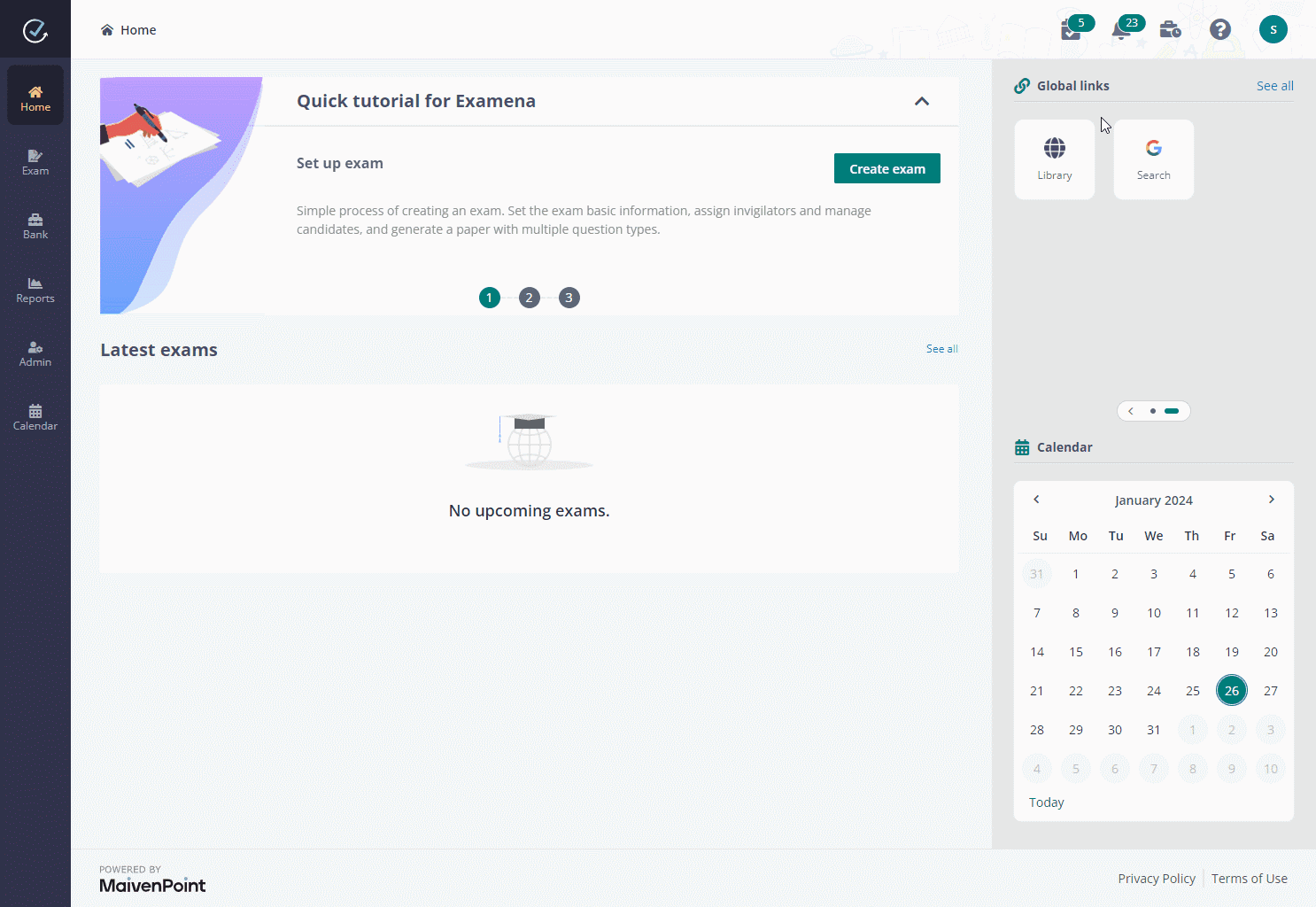
1. In Examena, click
Create exam in the quick tutorial for Examena.
2. Select the
classification for the exam, Flexible time range.
3. Enter a name for
the exam and select the Math 101 course.
4. Select
Open-book or Closed-book from the Type list.
5. Select an exam
open time and exam deadline from the calendar. After the exam is opened,
candidates can start the exam at any time before the exam deadline.
6. Select whether to
enable reading time for the exam by selecting No reading time or Set
reading time before exam. With reading time enabled, you can select a
reading duration.
7. Set an answering
duration for the exam. The exam end time for the candidate is calculated based
on the exam started time of the candidate, the reading duration (if reading time
is enabled), and the answering duration. For an open-book exam, you can select
No answering duration to allow candidates to access the exam at any time
of the exam period.
8. For an open-book
exam, you can set the Allowed number of attempts. Then, candidates can
attempt the exam multiple times.
9. Enter the
instruction for candidates if needed.
10. For a closed-book exam, you
can choose whether to enable a key for the exam. With a key enabled, candidate
will have to enter the key provided by the invigilator to start the exam. Then,
you can define the interval to update the key.
11. Enable chat box for the
exam to show the chat box for the exam. Candidates can send messages or
screenshots to invigilators, or call invigilators directly if they encounter any
issues during the exam.
12. Configure online proctoring
settings for the exam.
•
To use biometrics to map facial features from the captured faces
to match their photos in the system before the exam, complete the facial
recognition settings:
o Enable face
verification – With face verification enabled, candidates need to take a
photo that shows their full face from the front to complete the
verification.
o Enable ID verification
– With ID verification enabled, candidates need to take a photo of their
identification cards to complete the verification.
•
Enable environment check for the exam to ensure the
integrity and fairness. Candidates of the exam need to take a 360-degree
environmental video to complete the verification.
•
To use online proctoring service to monitor candidate activities
and screens for a comprehensive invigilator oversight during the exam, configure
the video proctoring settings:
o Enable screen
proctoring to monitor candidate screens during the exam. Select Enable
screen recording to record candidate screens while proctoring during the
exam.
o Enable candidate
proctoring to monitor candidate activities, and you can then select the
suspicious activities to proctor in real-time by selecting the corresponding
checkbox. Select Enable candidate recording to record candidate
activities while proctoring during the exam.
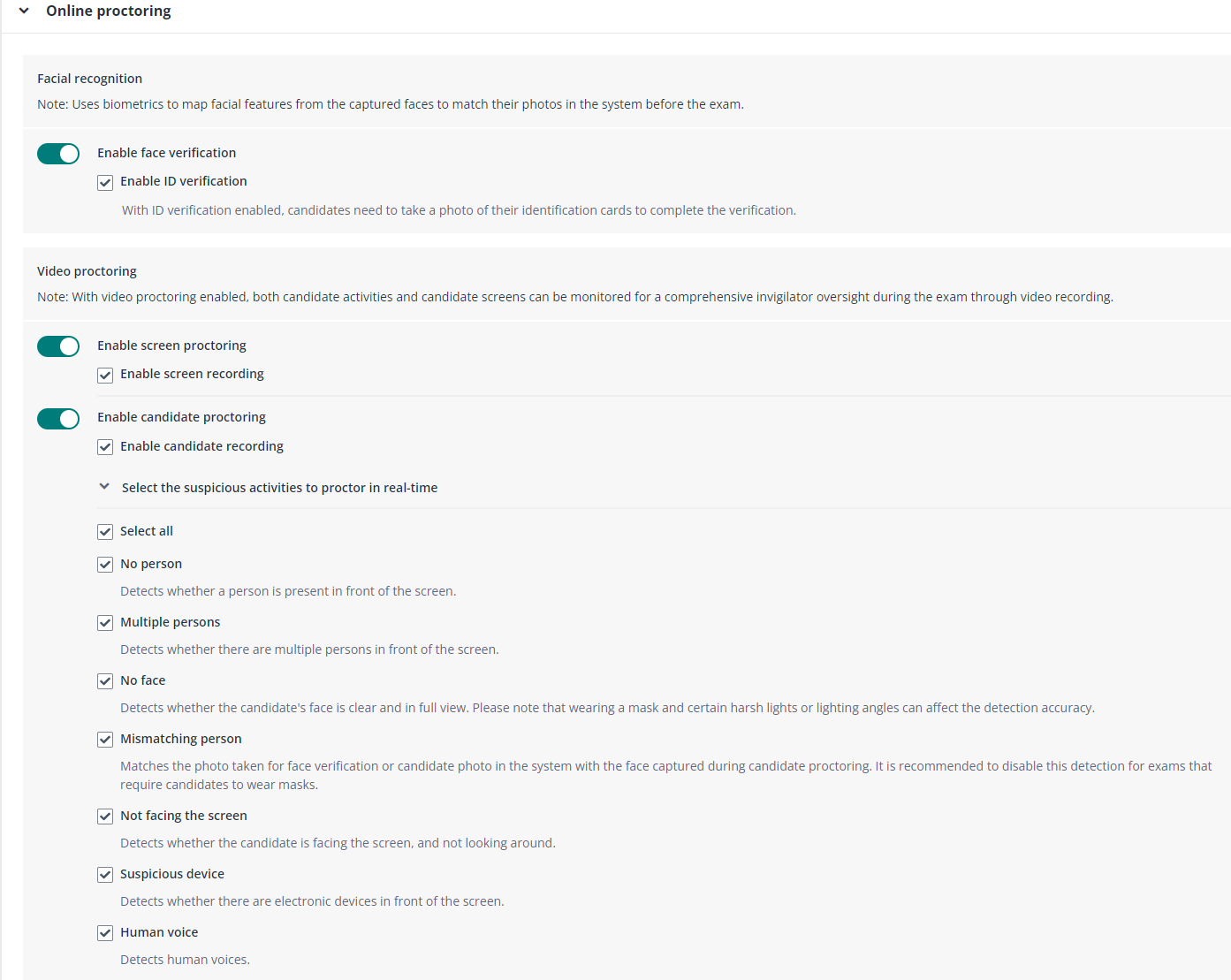
13. For the exam that is
closed-book, Do not allow access to the Internet is selected by default
in the Authorised URL section. To allow candidates to access authorised
URLs during the exam, select Allow access to specified URLs. Click Add
authorised URL to add an authorised URL.
•
Select Add existing authorised URLs to select the
authorised URLs prepared by the administrator.
•
Select Add authorised URL to add an authorised URL.
You can use one of the following methods to configure the
addresses that can be redirected from the URL:
o Click the Examena app
link in the How to authorise addresses? message to access Examena app.
Authorise the addresses that you want to allow candidates to be redirected from
the URL via Examena app.
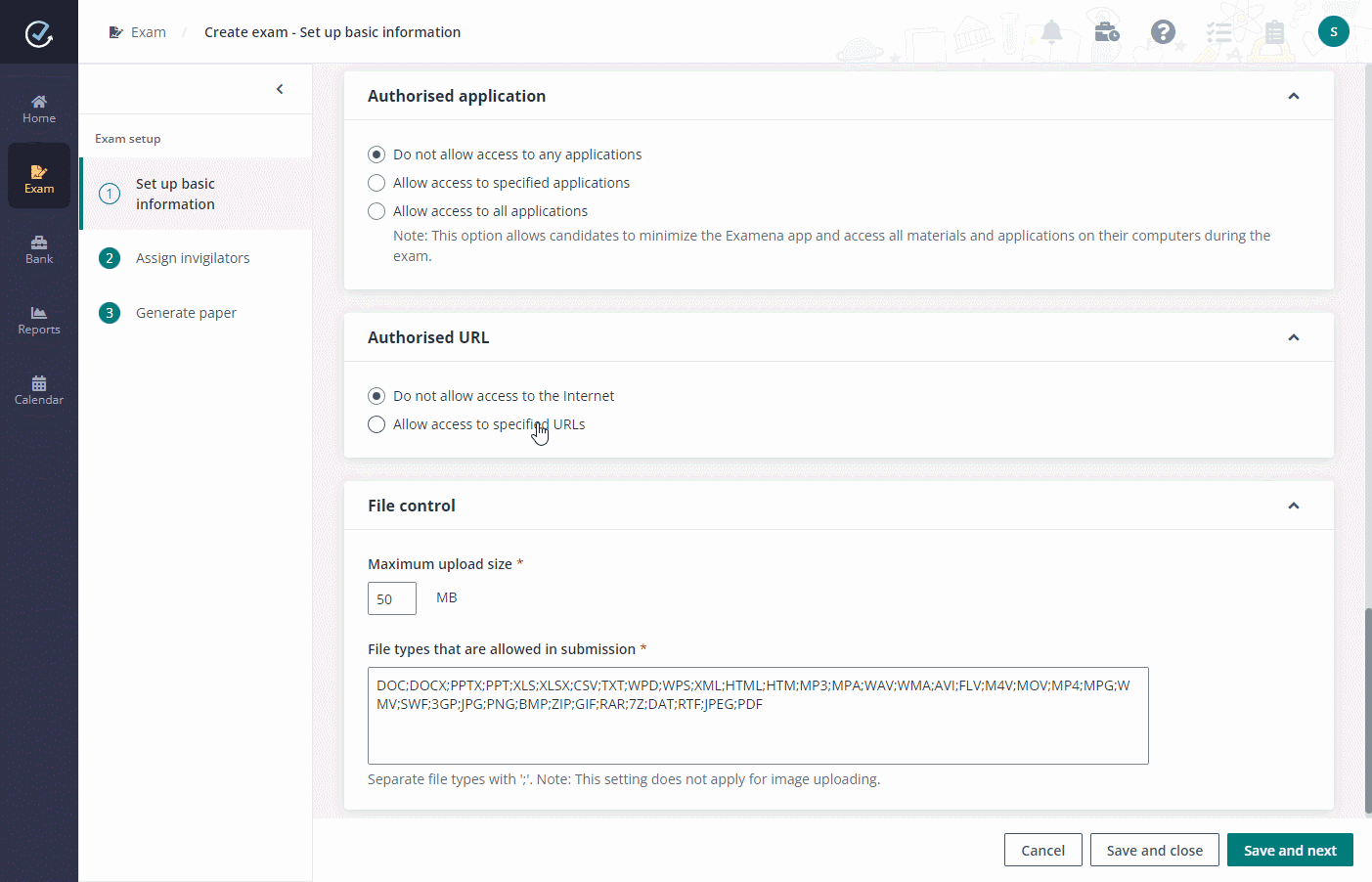
o Enter the URLs of the
addresses that can be redirected from the URL in the text box. Wildcard
characters are supported here.
*Note: If the website needs
login or authorisation and will redirect to another address, make sure the
address to be redirected is added here. For example, enter
https://login.microsoftonline.com/** for Microsoft Office Home.
14. For the exam that is
closed-book, Do not allow access to any applications is selected by
default in the Authorised application section.
To allow candidates to access the authorised applications
during the exam, select Allow access to specified applications. Click
Add authorised applications under Windows and/or Mac separately, select
the desired applications and click Add to add them as authorised
applications.
*Note: If there are Secured Excel and WordDoc
assignment questions in the paper used by the exam, Microsoft Excel and
Microsoft Word must be added as authorised applications for Windows and/or
macOS.
To allow candidates to access all applications during the
exam, select Allow access to all applications. Then, candidates are able
to minimize the Examena app during the exam. Candidate can access all materials
and applications on their computers, without a connection to the Internet.
15. Configure other settings for
the exam and click Save and next to go to the next step.
Then,
assign invigilators
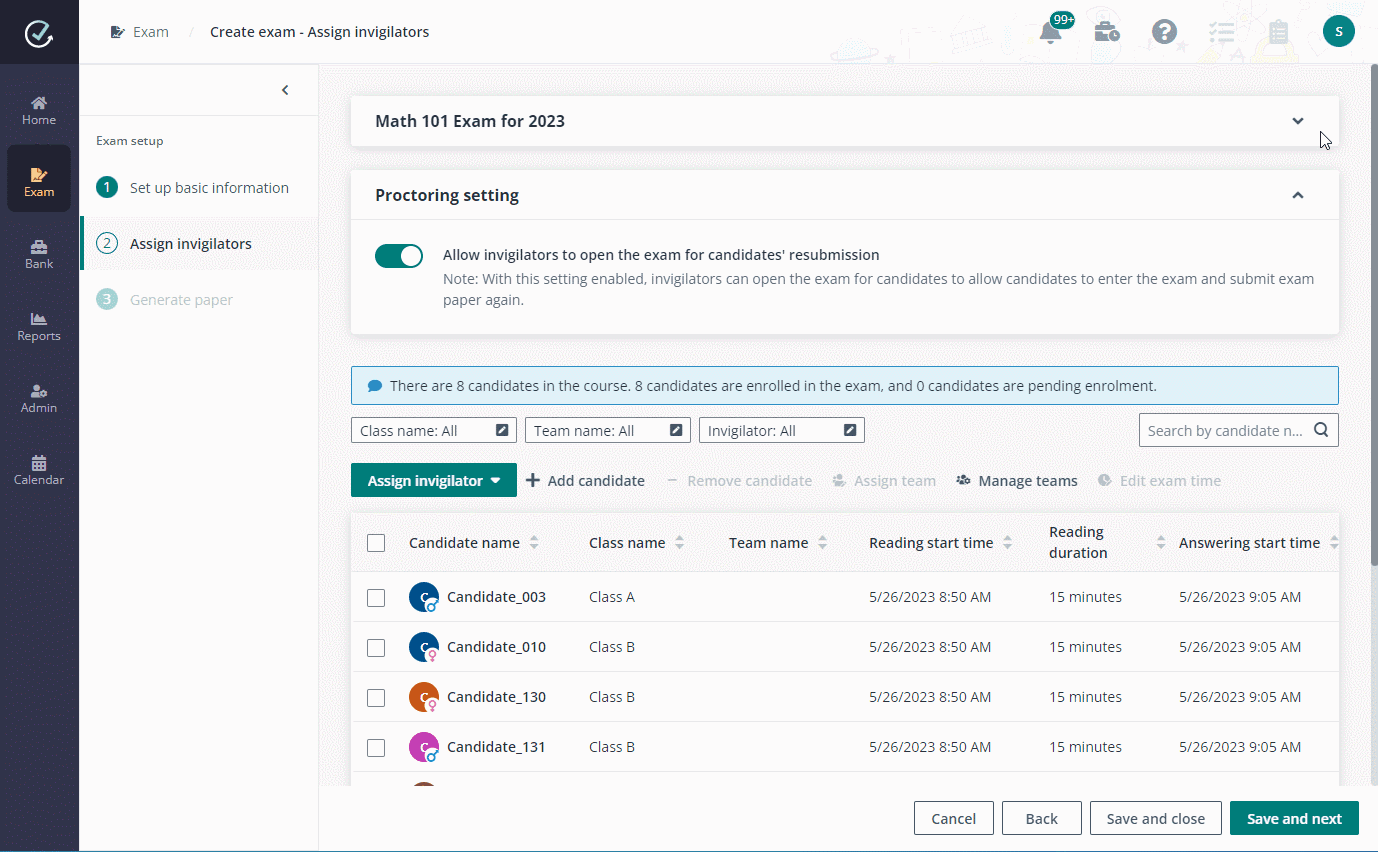
1. Choose whether to
allow invigilators to open the exam for candidates to resubmit their responses
by configuring the proctoring setting.
2. All candidates of
the course will be enrolled in the exam by default. You can remove candidates
from the exam by selecting the candidates and clicking Remove candidate.
3. The course
manager is the default invigilator. You can assign other invigilators to assist
you in the invigilation.
a. Select one or multiple candidates,
click Assign invigilator and select Assign invigilator for selected
candidates to assign invigilator for the selected candidates. To assign
invigilator for all candidates, click Assign invigilator and select
Assign invigilator for all.
b. Enter the staff name, staff ID, or
User ID in the text box and select the desired staff from the suggestion
list.
c. Click Save to add the staff as
invigilator.
4. If the candidates
of the course come from different classes, you can click Assign
invigilator and select Assign invigilator for classes.
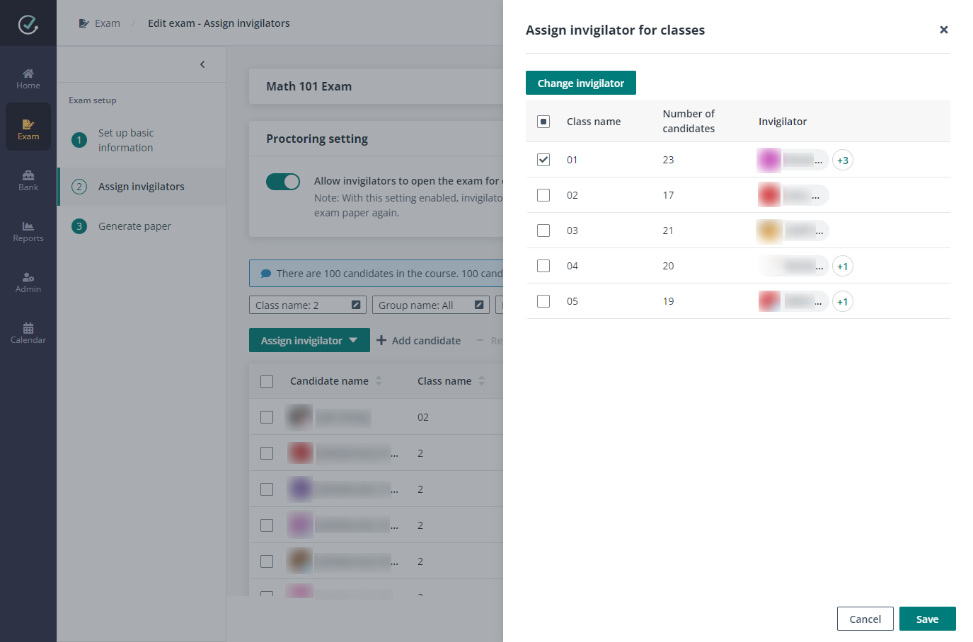
Select the classes for which you want to change
invigilator, and click Change invigilator.
5. If teams are
needed to classify candidates, you can click Manage teams. After clicking
Create team, enter a team name and click Save to create a
team.
6. Select the
candidates that you want to assign to the team, and click Assign team.
Select the team and click OK to assign the candidates to the team.
7. Click Assign
invigilator and select Assign invigilators for teams to display teams
with assigned invigilators.
Select one or multiple teams and click Change
invigilator to change the invigilator assignment for the teams.
8. For exams with
fixed time range, you can select candidates and click Edit exam time to
edit the exam time for the candidates that have special needs.
9. Click Save and
next to go to the next step.
You can generate a
paper for the
exam using one
of the following methods:

• Add
paper from bank
Click Add paper from
bank, select an existing paper from the paper bank, and click Add to
add the paper to the exam.
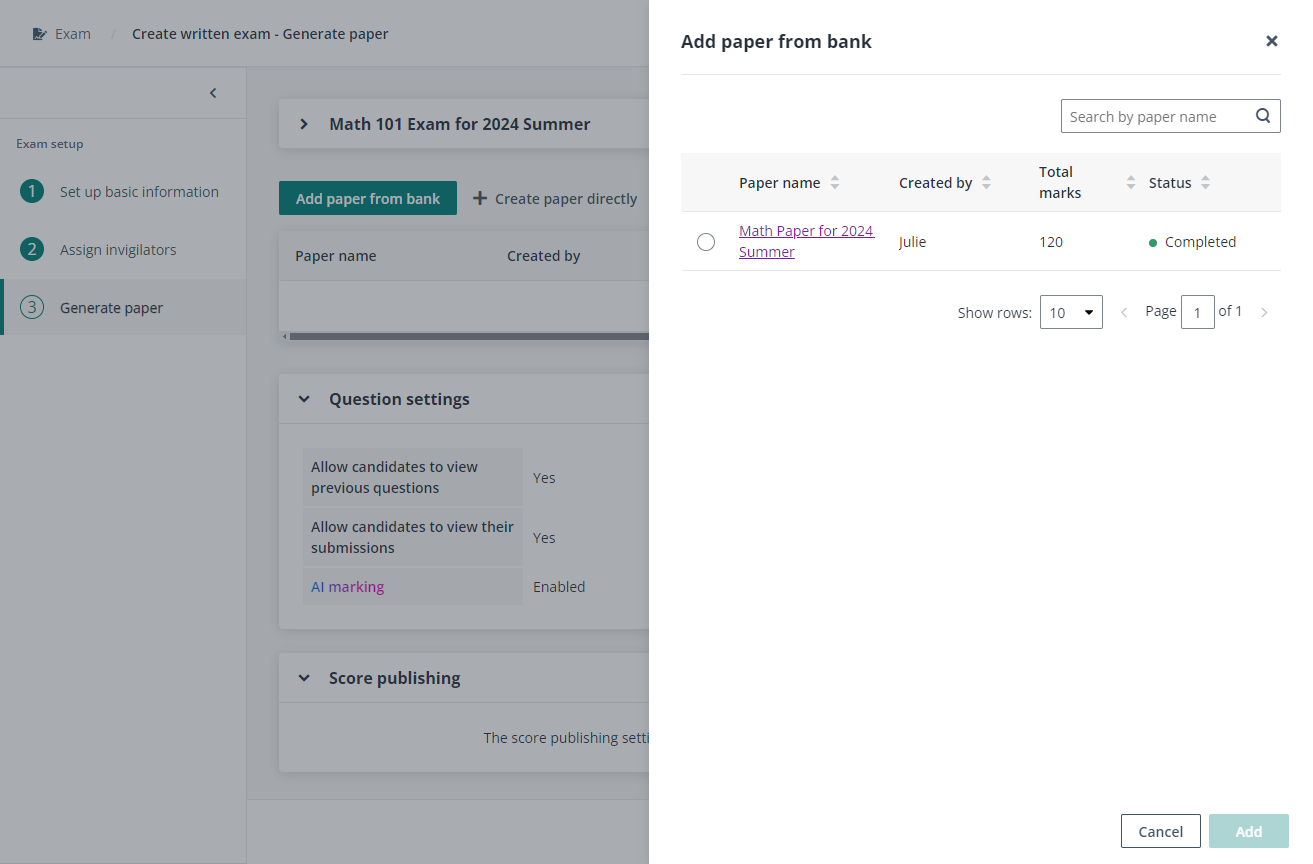
• Create
paper directly
Click Create paper
directly to create a new paper for the exam. Enter a name for the paper and
configure questions.
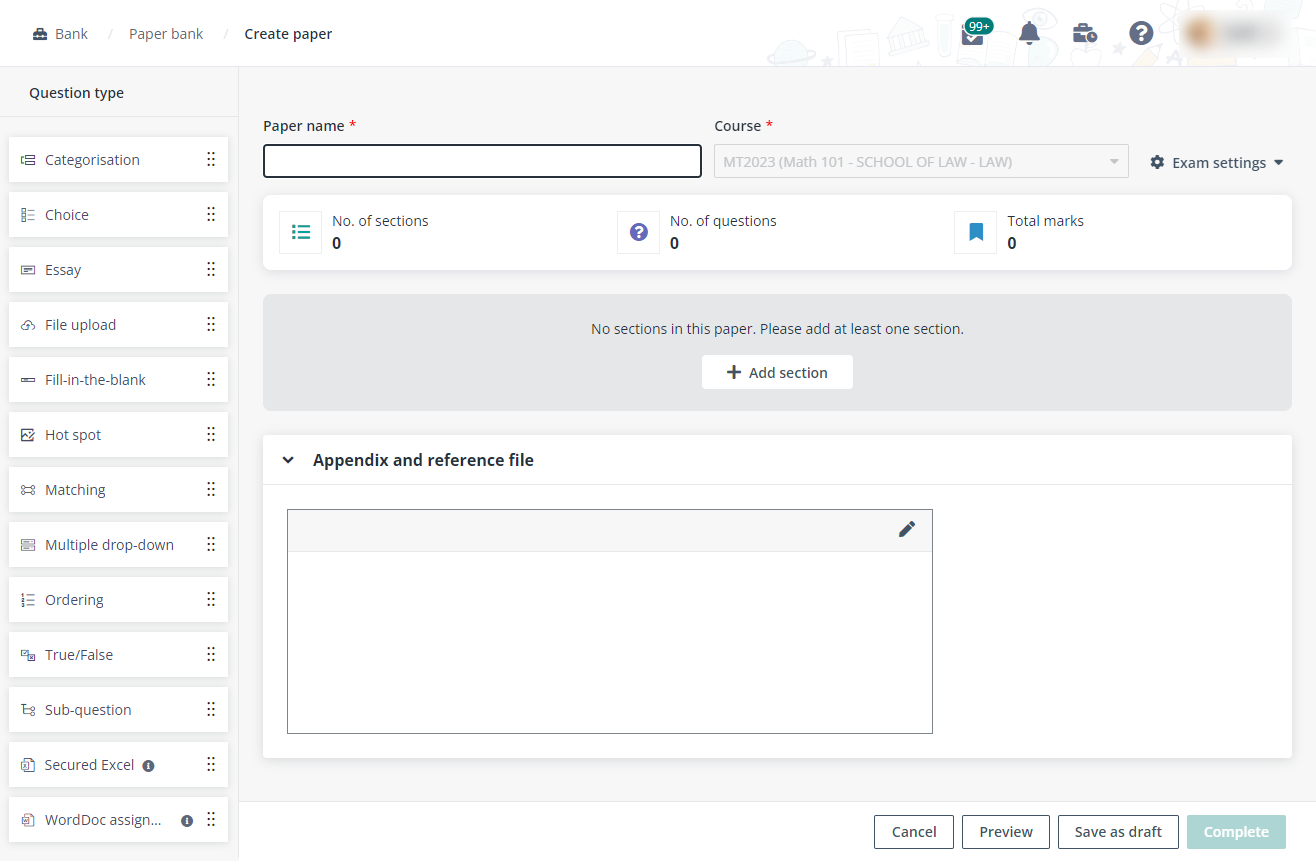
When you finish the paper
configuration, click Complete to make the paper Completed. For
detailed information on how to create questions, refer to How to create a
question?.
After generating a paper for the
exam, you can click Preview to preview the paper in marker view or
candidate view.
You can configure question settings by clicking the Edit
button in the Question settings section. In the Edit question
settings window, complete the following settings and click Save to
save the question settings for the exam.
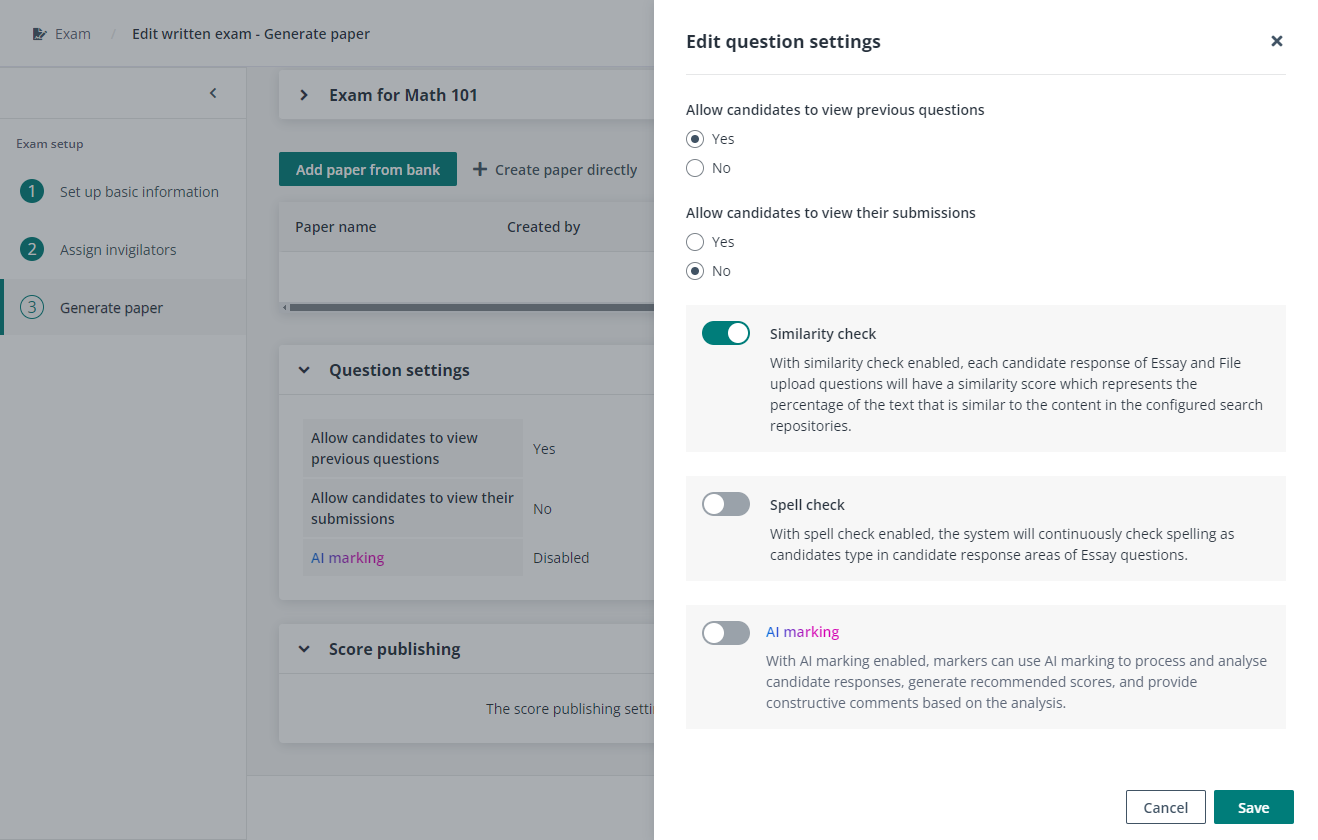
•
Select Yes or No in the Allow candidates to view
previous questions field to decide whether to allow candidates to go back
and view previous questions during the exam.
•
Select Yes or No in the Allow candidates to view
their submissions field to decide whether to allow candidates to view
questions and their responses before the exam results have been published.
•
Choose whether to enable similarity check. With similarity check
enabled, each candidate response of Essay and File upload questions in the paper
used by the exam will have a similarity score, which represents the percentage
of text that is similar to the content in the configured search
repositories.
•
Choose whether to enable spell check for candidates. With spell
check enabled, the system will check spelling when candidates type in candidate
response areas of Essay questions in the paper used by the exam. Spelling
mistakes will be underlined in red.
•
Choose whether to enable AI marking for the exam. With AI marking
enabled, markers can use AI to process and analyse candidate responses, generate
recommended scores, and provide constructive comments based on the analysis. For
details about the AI marking usage, refer to How to leverage AI to
mark scores for open-ended questions?.
You can configure publish settings after a paper has been
configured by clicking the Edit button in the Score publishing section.
In the Edit publish settings window, complete the following settings and
click Save to save the publish settings for the exam.
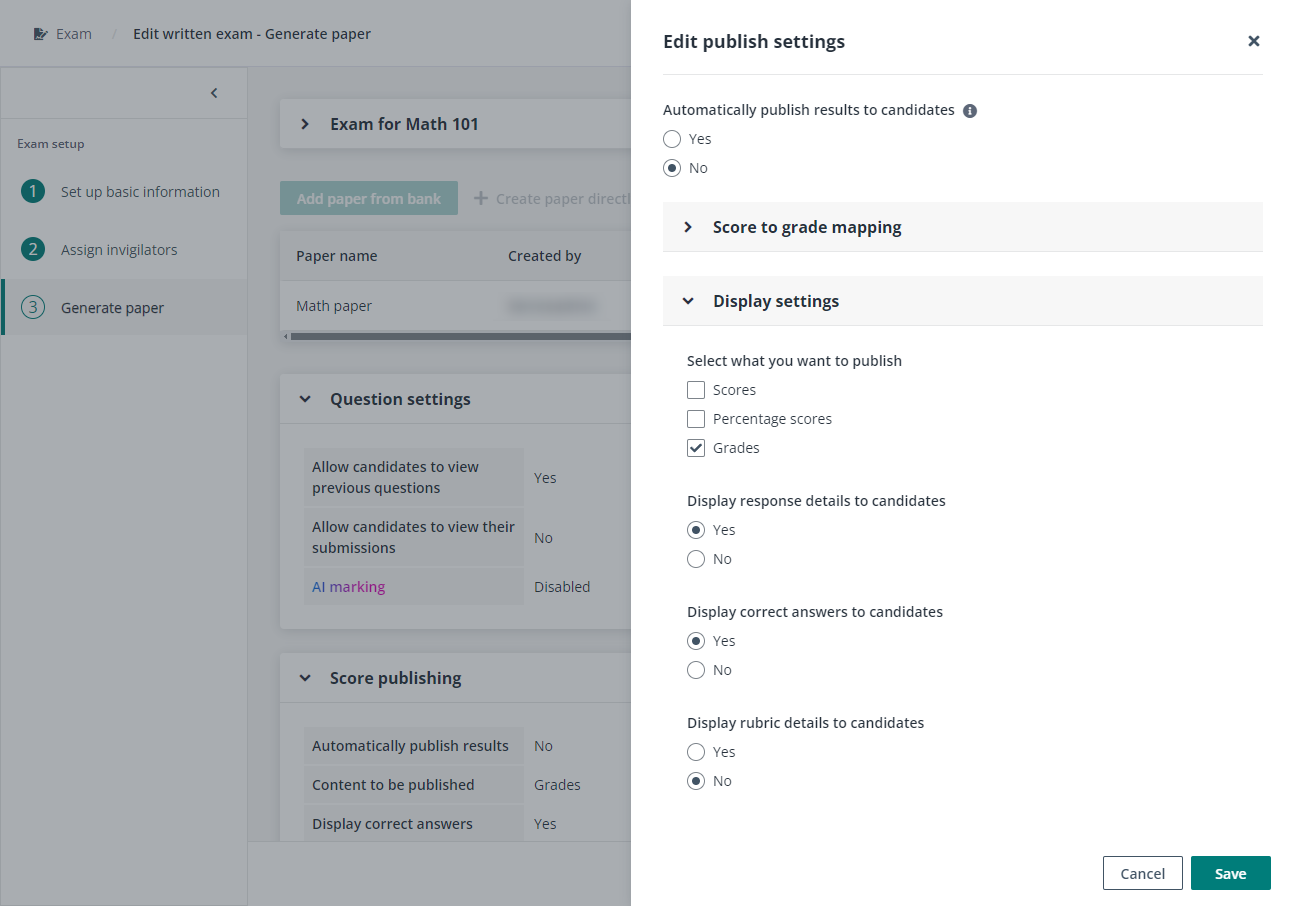
•
Select Yes or No in the Automatically publish
results to candidates field to decide whether to automatically publish exam
results for the submitted candidates. Only when all questions in the paper are
close-ended questions, which can be automatically marked, will the exam results
be published to the submitted candidates automatically.
•
Click the toggle button under Score to grade mapping to
enable score to grade mapping for this exam.
If there is a default mapping template configured by the
administrator, the score to grade mapping will be enabled automatically for this
exam.
o Configure the score to grade
mapping directly. Enter a number in Score from and a grade to define a
mapping, and click Add mapping to add more mappings.
o When the default mapping
template is automatically applied for the exam, you can adjust the grade mapping
based on the default template, and click Save to save changes to the
grade mapping for the exam.
o You can also click Change
grade mapping template, select a template from the drop-down list, and click
Apply to apply the selected mapping template to the exam. You can further
edit the grade mapping to meet your requirement for the exam, and click
Save to save changes.
•
Select Scores, Percentage scores, or Grades
to be published to candidates.
•
Select Yes or No in the Display response details
to candidates field to decide whether to display response details to
candidates together with the exam results.
•
Select Yes or No in the Display correct answers
to candidates field to decide whether to display correct answers to
candidates together with the response details.
•
Select Yes or No in the Display rubric details to
candidates field to decide whether to display rubric details, which includes
the rubric matrix, marking range and description of each criterion, to
candidates together with the response details.
You can click Save and preview exam to save the exam
and preview it in a new tab or via Examena app based on the exam type. When the
exam is ready, click Publish to publish the exam. Published exams can be
unpublished at any time before the exam starts.
To create a similar exam for the same course or reuse these
exam settings, you can duplicate this exam from the Exam page. You will
be brought to the Edit exam - Set up basic information page with
the same exam settings duplicated. Then, you can edit the exam as
required.









